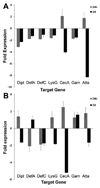The Toll immune signaling pathway control conserved anti-dengue defenses across diverse Ae. aegypti strains and against multiple dengue virus serotypes
- PMID: 20079370
- PMCID: PMC2917001
- DOI: 10.1016/j.dci.2010.01.006
The Toll immune signaling pathway control conserved anti-dengue defenses across diverse Ae. aegypti strains and against multiple dengue virus serotypes
Abstract
Dengue virus has become one of the most important arboviral pathogens affecting the world today. The virus is transmitted among humans by the mosquitoes Aedes aegypti and Ae. albopictus. Like other vector-borne pathogens, this virus encounters innate immune defenses within the mosquito vector that limit infection. We have previously demonstrated the involvement of the Toll pathway in the anti-dengue defense at 7 days after infection. In the present study, we have investigated the activity of this immune signaling pathway against different dengue virus serotypes at the early stages of infection in laboratory and field-derived mosquito strains. Our studies corroborate the importance of the Toll pathway in the anti-dengue defense repertoire at 3 days after an infectious blood meal, when new virions are released from the midgut for dissemination and infection of other mosquito tissues. These immune defenses are furthermore conserved among different Ae. aegypti strains and can act against a broad range of dengue virus serotypes.
Copyright 2010 Elsevier Ltd. All rights reserved.
Figures




References
-
- Gubler DJ, Rosen L. Variation among Geographic Strains of Aedes Albopictus in Suceptibility to Infection with Dengue Viruses. Am J Trop Med Hyg. 1976;25(2):318–325. - PubMed
-
- Hardy JL. Susceptibility and resistance of vector mosquitoes. The Arboviruses: Epidemiology and Ecology, TP. Monath. 1988;1:87–126.
-
- Hanley KA, Goddard LB, Gilmore LE, et al. Infectivity of West Nile/Dengue Chimeric Viruses for West Nile and Dengue Mosquito Vectors. Vector-Borne and Zoonotic Diseases. 2005;5(1):1–10. - PubMed
Publication types
MeSH terms
Substances
Grants and funding
LinkOut - more resources
Full Text Sources
Medical

